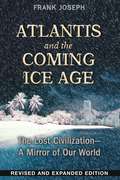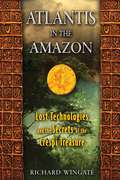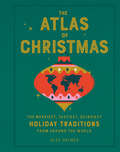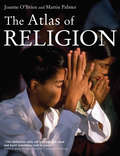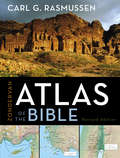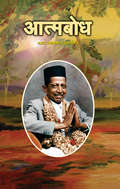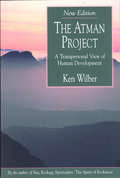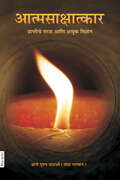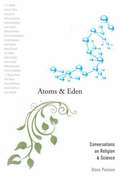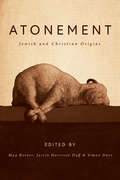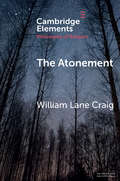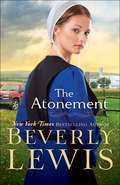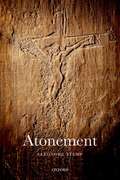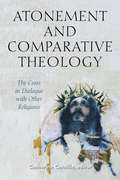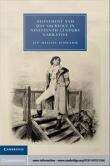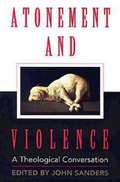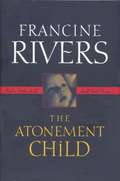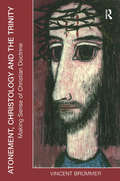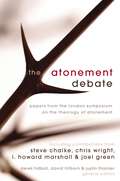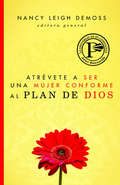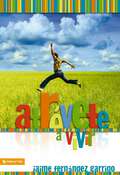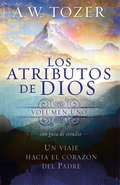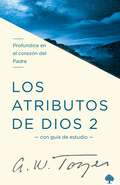- Table View
- List View
Atlantis and the Coming Ice Age: The Lost Civilization--A Mirror of Our World
by Frank JosephReveals the parallels between the rise and fall of Atlantis, cultures in ancient Mesoamerica, and our modern civilization • Links the demise of Atlantis with the birth of the Olmec civilization in Mexico, the beginning of the first Egyptian dynasty, and the start of the Mayan Calendar • Reveals the Atlantean and Mayan prophecy of an eternal cycle of global creation, destruction, and renewal and how we are headed into a destructive phase • Shows how ancient prophecies correlate precisely with the latest climatology studies, the rising incidence of solar flares, and papers from Pentagon and NASA analysts With the passing of the Mayan Calendar’s end date we can now focus on the true significance of what the Maya and their predecessors were trying to convey to future civilizations. Frank Joseph reveals how the Mayan prophecy, symbolized by their calendar, was created through the combined genius of Atlantis and Lemuria and predicts an eternal cycle of global creation, destruction, and renewal. He shows how this cycle correlates precisely with scientific studies on glacial ice cores and predictions from the Hopi, the Incas, and the Scandinavian Norse as well as the visions of Edgar Cayce. He links the demise of Atlantis with the birth of the Olmec civilization in Mexico (the progenitors of the Maya), the beginning of the first Egyptian dynasty, and the start of the Mayan Calendar. Drawing on the latest climatology studies and papers from Pentagon and NASA analysts, he reveals that we are on the brink of a destructive phase in the global cycle of change as predicted by the Atlanteans and the Maya. The world’s current political, economic, and cultural deterioration is paralleled by unprecedented storms and record temperatures, massive solar flares, tectonic disturbances, and fissuring sea floors that could release dangerous reservoirs of methane gas into the environment--all of which signals we are headed into another ice age. Despite the Atlanteans’ greater understanding of the cyclical nature of catastrophes and of the human role in them, Joseph reveals the mistakes they made that played a crucial role in their civilization’s destruction. By recognizing the self-destructive patterns of Atlantis in our own civilization, we can learn from their mistakes to reestablish civilization’s cosmic balance before time runs out.
Atlantis in the Amazon: Lost Technologies and the Secrets of the Crespi Treasure
by Richard WingateAn investigation into the ancient technologically advanced artifacts amassed by Father Carlo Crespi and how they offer proof of Atlantis in South America • Includes photos and descriptions of the strange machines and beautiful artifacts that once comprised the “Crespi Treasure” • Connects Crespi’s treasures to readings by Edgar Cayce and Annie Besant’s descriptions of Atlantean colonies in Ecuador • Reveals the nuclear war between the Atlanteans and the Aryans and the radioactive evidence left behind in the Bahamas and Pakistan In 1923 an Italian priest, Father Carlo Crespi, came to Ecuador as a missionary. Befriending the indigenous Shuar people, he learned of an ancient treasure they had sworn to protect hidden within a network of underground tunnels. As newly converted Christians, the Shuar wanted to share with their priest these amazing anachronistic artifacts--golden sarcophagi from Egypt, bronze plaques depicting famous scenes from antiquity bearing both Quechua and Phoenician writing, copper wheels and gears as hard as steel, strange machines, and many other inexplicable items. Crespi faithfully maintained the collection until just before his death when the Ecuadorian government purchased it from the church and many of these priceless treasures were lost forever. Providing detailed descriptions and his own photos of the advanced technologies and beautiful art that comprised the “Crespi Treasure,” Richard Wingate reveals that the ancient civilization responsible for these advanced artifacts was Atlantis. Connecting Crespi’s treasures to Edgar Cayce’s descriptions of advanced technology in the distant past and the Atlantean colonies of Ecuador described by Annie Besant, Wingate explores other evidence of Atlantis in South America and the Bahamas, including geographically out-of-place underwater ruins and buried magnetic ore. Investigating ancient records, such as the Mahabharata, he shows how a prehistoric nuclear war between the Atlanteans and the Aryans ultimately resulted in the sinking of Atlantis, and he uncovers the radioactive archaeological evidence left behind. Explaining how our ancient ancestors regretted their nuclear actions and destroyed or buried their advanced technology, entering into a self-imposed Stone Age, he shows how our civilization is headed down the same path and that only through “green” choices can we avoid the same fate as Atlantis.
The Atlas of Christmas: The Merriest, Tastiest, Quirkiest Holiday Traditions from Around the World
by Alex PalmerDiscover the fascinating (and sometimes downright odd!) ways that people and nations celebrate the holiday season and share this festive compendium's unique traditions together with family and friends.Do you know that in Guatemala there's a "Burn the Devil" tradition to kick off the Christmas season, where revelers gather to set fire to devil-piñatas? In Sweden, a popular figure in Christmas traditions is the Yule Goat, a rowdy, menacing character who demands gifts. And in Japan, a big bucket of Kentucky Fried Chicken has become the classic Christmas Day feast. These and many other global Christmas traditions are featured here in this delightful book. From decorations and activities to feasts and special treats, there's a wide range of both lovely and unusual traditions from around the globe.
The Atlas of Religion
by Martin Palmer Joanne O'BrienThe world's religions have emerged as one of the greatest geopolitical forces now shaping our lives. Now available in an updated edition, this authoritative atlas is an essential resource for understanding the powerful role of religion around the globe. In an accessible text packed with information, it maps the current nature, extent, and influence of each of the major religions and shows, country by country, how religions are spread through broadcasting, missionary work, schooling, and banking; how they relate to government, laws, and world hunger; and the role they play in wars. It traces the emergence of new religious movements, the survival of traditional beliefs, and the presence of atheism and agnosticism. The Atlas of Religion also locates the origin, the heartland, and the sacred places of each of the major religions and provides essential background with a valuable table showing the fundamental beliefs of Buddhism, Christianity, Hinduism, Islam, Judaism, Sikhism, and Taoism. Copub: Myriad Editions Limited
Atlas of the Bible: Revised Edition
by Carl G. RasmussenZondervan Atlas of the Bible . . . a thoroughly revised edition of the most comprehensive Bible atlas ever designed for * Students * Bible Study Groups * Adult Learners * Travelers/Pilgrims to the Lands of the Bible * Pastors * Teachers * All Lovers of the Bible This major revision of the Gold Medallion Award-winning Zondervan NIV Atlas of the Bible is a visual feast that will help you experience the geography and history of Scripture with unprecedented clarity. The first section of the Atlas introduces the "playing board" of biblical history--using three-dimensional maps and photographic images to help the lands of the Bible come alive. The next section, arranged historically, begins with Eden and traces the historical progression of the Old and New Testaments. It provides an engaging, accurate, and faithful companion to God's Word--illuminating the text with over one hundred full-color, multidimensional maps created with the help of Digital Elevation Modeling data. It concludes with chapters on the history of Jerusalem, the disciplines of historical geography, and the most complete and accurate listing and discussion of place-names found in any atlas. Throughout the Atlas, innovative graphics, chronological charts, and over one hundred specially selected images help illuminate the geographical and historical context of biblical events. The Zondervan Atlas of the Bible is destined to become a favorite guide to biblical geography for students of the Bible. This accessible and complete resource will assist you as you enter into the world of the Bible as never before.
Atmabodh: आत्मबोध
by Dada Bhagwanप्रस्तुत संकलन में प्रकट प्रत्यक्ष ज्ञानी के स्वमुख से प्रवाहित आत्मतत्व, और अन्य तत्वों सम्बन्धी वास्तविक दर्शन खुला होता है| आत्मा के अस्तित्व की आशंका से लेकर, आत्मा क्या होगा, कैसा होगा, क्या करता होगा, जन्म मरण क्या है, किसके जन्म मरण, कर्म क्या है, चार गतियाँ क्या है, उसकी प्राप्ति के रहस्य, मोक्ष क्या है, सिद्धगति क्या है, जैसे अनेकों प्रश्नों के समाधान यहाँ पर हैं| जीव क्या है? शिव क्या है? द्वैत, अद्वैत, ब्रह्म, परब्रह्म, आत्मा की सर्वव्यापकता, कण कण में भगवान्, वेद और विज्ञानं वगैरह अनेक वेदान्त के रहस्य यहाँ पर अनावृत हुए हैं| तमाम शास्त्रों का, साधकों का, साधनाओ का सार एक ही है कि खुद के आत्मा का भान करना, ज्ञान प्राप्त कर लेना है| ‘मूल आत्मा’, तो शुद्ध ही है मात्र ‘खुद’ को रोंग बिलीफ बैठ गई है, प्रकट ‘ज्ञानीपुरुष’ के पास यह मान्यता छूट जाती है| जो कोटि जन्मों तक नहीं हो पाता, वह ‘ज्ञानी’ के पास से प्राप्त हो सकता है| विश्व में कभी कभार आत्मज्ञानी पुरूष अवतरित होते हैं, तभी यह आध्यात्मिक रहस्य खुल्ला हो पाता है| संसार में जो भी ज्ञान है, वह भौतिक ज्ञान है| उससे आत्म साक्षात्कार कभी नहीं हो सकता| ज्ञानीपुरुष को आत्मा का अनुभव होने से आत्म साक्षात्कार की प्राप्ति हो सकती है| प्रस्तुत संकलन में संपूज्य श्री दादाश्री ने खुद के ज्ञान में ‘जैसा है वैसा’ आत्मा का स्वरुप और जगत का स्वरुप देखा है, जाना है, अनुभव किया है, उस सम्बन्ध में उनके ही श्रीमुख से निकली हुई वाणी का यहाँ पर संकलन किया गया है, जो अध्यात्म मार्ग में पदापर्ण करनेवालों को आत्मसमुख होने में अत्यंत उपयोगी सिद्ध होगी|
The Atman Project
by Ken WilberWilber traces human development from infancy into adulthood and beyond, into those states described by mystics and spiritual adepts. The spiritual evolution of such extraordinary individuals as the Buddha and Jesus hints at the direction human beings will take in their continuing growth toward transcendence.
Atmasakshatkar: आत्मसाक्षात्कार
by Dada Bhagwanजीवमात्र क्या ढूंढता है? आनंद ढूंढता है, लेकिन घड़ीभर भी आनंद नहीं मिल पाता | विवाह समारोह में जाएँ या नाटक में जाएँ, लेकिन वापिस फिर दुःख आ जाता है | जिस सुख के बाद दुःख आए, उसे सुख ही कैसे कहेंगे? वह तो मूर्छा का आनंद कहलाता है | सुख तो परमानेन्ट होता है | यह तो टेम्परेरी सुख हैं और बल्कि कल्पित हैं, माना हुआ है | हर एक आत्मा क्या ढूंढता है? हमेशा के लिए सुख, शाश्वत सुख ढूंढता है | वह ‘इसमें से मिलेगा, इसमें से मिलेगा | यह ले लूँ, ऐसा करूँ, बंगला बनाऊ तो सुख आएगा, गाड़ी ले लूँ तो सुख मिलेगा’, ऐसे करता रहता है | लेकिन कुछ भी नहीं मिलता | बल्कि और अधिक जंजालों में फँस जाता है | सुख खुद के अंदर ही है, आत्मा में ही है | अत: जब आत्मा प्राप्त करता है, तब ही सनातन (सुख) ही प्राप्त होगा |
The Atom Speaks: And Echoes The Word Of God
by D. Lee Chesnut“The heavens declare the glory of God; and the firmament showeth his handiwork. Day unto day uttereth speech and night unto night showeth knowledge. There is no speech nor language where their voice is not heard. Their line is gone out through all the earth, and their words to the end of the world....” (From the 19th Psalm)For thousands of years, man has had the benefit of this unfailing and majestic language of the universe as a testimony to God’s greatness and to his planning on what is, to us, an infinite scale. We have also, in the Bible, the preserved record of the birth, the life, the death and the resurrection of Christ, followed by his ascension into heaven and his promised eventual return to earth; and we have, in the Bible, a full and clear statement of the purpose of Christ with respect to man….If the heavens have declared the glory of God for thousands of years, may it not be the role of God’s infinitesimally small universe—the atom—to speak to us now of the plan of God in addition to giving us new vistas of the glory of God? And would this not be a peculiarly appropriate and forceful means for God to choose in speaking to this age of highly intelligent, self-reliant more than God-reliant people?If so, and if the Bible has truly been God’s faithful word to man through the centuries, then nuclear science cannot be at disharmony with the Bible. And so it is, the author believes, that the atom speaks and echoes the Word of God.
Atoms and Eden: Conversations on Religion and Science
by Steve PaulsonHere is an unprecedented collection of twenty freewheeling and revealing interviews with major players in the ongoing--and increasingly heated--debate about the relationship between religion and science. These lively conversations cover the most important and interesting topics imaginable: the Big Bang, the origins of life, the nature of consciousness, the foundations of religion, the meaning of God, and much more. In Atoms and Eden, Peabody Award-winning journalist Steve Paulson explores these topics with some of the most prominent public intellectuals of our time, including Richard Dawkins, Karen Armstrong, E. O. Wilson, Sam Harris, Elaine Pagels, Francis Collins, Daniel Dennett, Jane Goodall, Paul Davies, and Steven Weinberg. The interviewees include Christians, Buddhists, Jews, and Muslims, as well as agnostics, atheists, and other scholars who hold perspectives that are hard to categorize. Paulson's interviews sweep across a broad range of scientific disciplines--evolutionary biology, quantum physics, cosmology, and neuroscience--and also explore key issues in theology, religious history, and what William James called ''the varieties of religious experience. '' Collectively, these engaging dialogues cover the major issues that have often pitted science against religion--from the origins of the universe to debates about God, Darwin, the nature of reality, and the limits of human reason. These are complex, intellectually rich discussions, presented in an accessible and engaging manner. Most of these interviews were originally published as individual cover stories for Salon. com, where they generated a huge reader response. Public Radio's "To the Best of Our Knowledge" will present a major companion series on related topics this fall. A feast of ideas and competing perspectives, this volume will appeal to scientists, spiritual seekers, and the intellectually curious.
Atonement: Jewish and Christian Origins
by Max Botner Justin Harrison Duff Simon DürrA historical survey of atonement theology through ancient Jewish and Christian sources What is the historical basis for today’s atonement theology? Where did it come from, and how has it evolved throughout time? <P><P>In Atonement, a sterling collection of renowned biblical scholars investigates the early manifestations of this core concept in ancient Jewish and Christian sources. Rather than imposing a particular view of atonement upon these texts, these specialists let the texts speak for themselves so that the reader can truly understand atonement as it was variously conceived in the Hebrew Bible, the Dead Sea Scrolls, the Pseudepigrapha, the New Testament, and early Christian literature. The resulting diverse ideas mirror the manifold perspectives on atonement today. Contributors to this volume—Christian A. Eberhart, Crispin Fletcher-Louis, Martha Himmelfarb, T. J. Lang, Carol A. Newsom, Deborah W. Rooke, Catrin H. Williams, David P. Wright, and N. T. Wright—attend to the linguistic elements at work in these ancient writings without limiting their scope to explicit mentions of atonement. Instead, they explore atonement as a broader phenomenon that negotiates a constellation of features—sin, sacrifice, and salvation—to capture a more accurate and holistic picture. Atonement will serve as an indispensable resource for all future dialogue on these topics within Jewish and Christian circles.
The Atonement (Elements in the Philosophy of Religion)
by William Lane CraigHow did Christ's death overcome the estrangement and condemnation of sinners before a holy God, so as to reconcile them to Him? A great variety of theories of the atonement have been offered over the centuries to make sense of the fact that Christ by his death has provided the means of reconciliation with God: ransom theories, satisfaction theories, moral influence theories, penal substitution theories, and so on. Competing theories need to be assessed by (i) their accord with biblical data and (ii) their philosophical coherence.
The Atonement
by Beverly LewisBack Cover: "The mistakes of the past haunt Lucy Flaud, now twenty-five and beyond Amish courting age. Instead, Lucy focuses on volunteering in both the Plain and fancy communities of Lancaster County. Yet no matter how hard she strives, she never feels she's doing enough. Then her father strikes up an unexpected friendship with an Englischer in search of a simpler way of life. Lucy forms a connection of her own with the thoughtful young man even as she rejects courtship with her longtime Amish friend. Is it too late to embrace redemption... and the power of love?"
The Atonement
by Leon MorrisThe book looks at the meaning of the atonement with chapters on covenant, sacrifice, Passover, Day of Atonement, reconciliation, propitiation, and justification. The author says: This book is written out of the conviction that the cross is at the heart of the Christian way. This is the way of salvation and it is the way of Christian living. I have tried to bring out for people who are not experts in theology or in the study of the biblical languages something of the meaning of the great terms used in the New Testament to convey the significance of the atoning work of Christ. The cross is central to Christianity. It is the new and living way into the very presence of God.
Atonement (Oxford Studies in Analytic Theology)
by Eleonore StumpIn their place, she argues for an interpretation that is both novel and yet traditional and that has significant advantages over other interpretations, including Anselms well-known account of the doctrine. In the process, she also discusses love, union, guilt, shame, forgiveness,retribution, punishment, shared attention, mind-reading, empathy, and various other issues in moral psychology and ethics.
Atonement and Comparative Theology: The Cross in Dialogue with Other Religions (Comparative Theology: Thinking Across Traditions #9)
by Catherine CornilleThe central Christian belief in salvation through the suffering, death, and resurrection of Jesus Christ remains one of the most intractable mysteries of Christian faith. Throughout history, it has given rise to various theories of atonement, many of which have been subject to critique as they no longer speak to contemporary notions of evil and sin or to current conceptions of justice. One of the important challenges for contemporary Christian theology thus involves exploring new ways of understanding the salvific meaning of the cross.In Atonement and Comparative Theology, Christian theologians with expertise in Judaism, Islam, Hinduism, Buddhism, Daoism, and African Religions reflect on how engagement with these traditions sheds new light on the Christian understanding of atonement by pointing to analogous structures of sin and salvation, drawing attention to the scandal of the cross as seen by the religious other, and re-interpreting aspects of the Christian understanding of atonement. Together, they illustrate the possibilities for comparative theology to deepen and enrich Christian theological reflection.
Atonement and Self-Sacrifice in Nineteenth-Century Narrative
by Jan-Melissa SchrammJan-Melissa Schramm explores the conflicted attitude of the Victorian novel to sacrifice, and the act of substitution on which it depends. The Christian idea of redemption celebrated the suffering of the innocent: to embrace a life of metaphorical self-sacrifice was to follow in the footsteps of Christ's literal Passion. Moreover, the ethical agenda of fiction relied on the expansion of sympathy which imaginative substitution was seen to encourage. But Victorian criminal law sought to calibrate punishment and culpability as it repudiated archaic models of sacrifice that scapegoated the innocent. The tension between these models is registered creatively in the fiction of novelists such as Dickens, Gaskell and Eliot, at a time when acts of Chartist protest, national sacrifices made during the Crimean War, and the extension of the franchise combined to call into question what it means for one man to 'stand for', and perhaps even 'die for', another.
Atonement and Violence: A Theological Conversation
by T. Scott Daniels Hans Boersma J. Denny Weaver Thomas N. Finger John SandersRecent years have witnessed a series of books, articles, and lectures raising serious questions about the Christian doctrine of the Atonement. While coming from a variety of sources, the questions usually center around the central issue of atonement and violence. Doesn't the Atonement promote the idea of violence on the part of God? If so, isn't such violence incompatible with a God of love? Doesn't this doctrine send the wrong signal, excusing and perhaps even promoting such things as child abuse? Is it time to abandon what has become an outmoded and harmful doctrine? The authors of this book claim that to abandon the Christian doctrine of the Atonement is to abandon the central witness of the gospel, for atonement speaks of nothing less than God's reconciliation of the world in the life, death, and resurrection of Jesus Christ. However, to believe in the atoning death of Jesus Christ does not mean that one believes that God has engaged in cosmic child abuse. Drawing on the classical theories of the Atonement, engaging in creative theological construction, they present set of cogent, cohesive alternatives to either rejecting the doctrine out of hand, or uncritically accepting it. Contributors include: J. Denny Weaver, Bluffton University: "Narrative Christus Victor: The Answer to Anselmian Atonement Violence"; Thomas Finger, Associated Mennonite Seminary: "Christus Victor as Nonviolent Atonement"; Hans Boersma, Regent College, Vancouver, British Columbia: "Violence, the Cross, and Divine Intentionality: A Modified Reformed View"; and T. Scott Daniels, Pasadena First Church of the Nazarene: "Passing the Peace: Worship That Shapes Nonsubstitutionary Convictions."
The Atonement Child
by Francine RiversDynah Carey knew where her future was headed. She was engaged to a wonderful man, the daughter of doting parents, a faithful child of God. Then, in one horrific, terrifying moment, the unthinkable unpardonable happens. Dynah's perfect life is shattered by rape, her future irrevocably altered by an unwanted pregnancy, her family torn apart. Her seemingly rock-solid faith is pushed to the limits as she faces the most momentous choice of her life--to embrace or to end the untimely life within her.
Atonement, Christology and the Trinity: Making Sense of Christian Doctrine
by Vincent Br�mmerFor many believers today the doctrines of Atonement, Christology and the Trinity seem like puzzling constructions produced by academic theologians. They are cast in unintelligible forms of thought derived from Platonism or from feudal society, and for many their existential relevance for life today remains unclear. This book introduces these doctrines and proposes a reinterpretation in the light of the claim of many Christian mystics that ultimate happiness is to be found in enjoying the loving fellowship of God. This claim is amatrix of faith in terms of which these doctrines are shown to be relevant for the life of faith of believers today. Furthermore, since this matrix can be defended within all three Abrahamic traditions, Judaism, Christianity and Islam, the proposed understanding of these doctrines can also contribute usefully to the necessary dialogue between these traditions in a globalised world.
The Atonement Debate: Papers from the London Symposium on the Theology of Atonement
by David Hilborn Derek Tidball Justin ThackerRecent days have seen a debate among evangelicals over how the death of Christ is to be interpreted. When a popular British evangelical leader appeared to denounce the idea that God was punishing Christ in our place on the cross as a "twisted version of events," "morally dubious," and a "huge barrier to faith" that should be rejected in favour of preaching only that God is love, major controversy was stirred. Many thought the idea of penal substitution was at the heart of the evangelical understanding of the cross, if not the only legitimate interpretation of the death of Christ. Yet for some time less popular evangelical theologians had been calling this traditional interpretation of the atonement into question. So, is the traditional evangelical view of penal substitution the biblical explanation of Christ’s death or one of many? Is it the non-negotiable heart of evangelical theology or a time-bound explanation that has outlived its usefulness? What does the cross say about the character of God, the nature of the law and sin, the meaning of grace, and our approach to missions? The public debate which resulted was often heated. In order to act as reconcilers, the Evangelical Alliance and the London School of Theology called for a symposium in which advocates of the different positions could engage with each other. The symposium, which was attended by some 200 participants, was held when the July 7th bombings took place in London and drew together many of Britain’s finest evangelical theologians. This book contains the collection of papers given at the symposium, supplemented by a few others for the sake of rounding out the agenda, and grouped in convenient sections.
Atrévete a ser una mujer conforme al plan de Dios
by Nancy Leigh DemossSe creía que la revolución feminista traería mayor satisfacción y libertad para las mujeres. Sin embargo, no se sienten realizadas y libres porque han perdido la maravilla y riqueza de su vocación como mujeres. Hay un nuevo movimiento que está esparciendo semillas de esperanza, humildad, obediencia y oración. Es un llamado a regresar a una femineidad piadosa, y está resonando en el corazón de mujeres de todas partes mediante la sabiduría de mentoras como Nancy Leigh DeMoss, Susan Hunt, Mary Kassian, Carolyn Mahaney, Barbara Hughes, P. Bunny Wilson y Dorothy Patterson. Now a movement is spreading seeds of hope, humility, obedience, and prayer--a call to return to godly womanhood--and its truth will resound in the hearts of readers through the powerful messages of Nancy Leigh DeMoss, Susan Hunt, Mary Kassian, Carolyn Mahaney, Barbara Hughes, P. Bunny Wilson, and Dorothy Patterson. Available in English from Moody Publishers.
Atrévete a vivir
by Jaime Fernández GarridoAtención: Las autoridades sanitarias advierten que la lectura de este libro puede ocasionar efectos secundarios irreversibles, tales como: ilusión por la vida, pasión, descanso, cariño por la familia, ganas de hablar con los amigos y deseos de abrazar.
Los atributos de Dios - vol. 1 (Incluye guía de estudio): Un viaje al corazón del Padre
by A. W. TozerDios es: Infinitud, Inmensidad, Bondad, Justicia, Misericordia, Gracia, Omnipresencia, Inmanencia, Santidad, Perfección ¿Cómo es Dios? Para A.W. Tozer, no hay pregunta más importante. De hecho, el deseo de Tozer de conocer a Dios y su plenitud consumió su vida entera y ministerio. Originalmente predicado como sermones en la iglesia Southside Alliance Church en Chicago, este primer volumen de Los atributos de Dios examina diez atributos de Dios y revela cuan importante es para nosotros el tener un conocimiento del Santo. Una guía de estudio ha sido añadida para una mirada más profunda de cada atributo. “Si un sermón se puede comparar con una luz, entonces A.W. Tozer lanza un rayo láser desde el púlpito, un rayo que penetra el corazón”. -Warren Wiersbe, maestro de la Palabra y Director General de Back to the Bible Broadcast por diez años y antiguo pastor de la iglesia Moody en Chicago.
Los Atributos de Dios - Vol.2 (Incluye Guía de Estudio): Más profundamente en el corazón del Padre
by A. W. TozerAtributos de Dios: la auto-existencia , la trascendencia, su eternidad, su omnipotencia, la sabiduría, la soberanía, la fidelidad, y el amor. "Debemos conocer a Dios de nuevo", A.W. Tozer escribe con urgencia en su introducción a este segundo volumen "Los atributos de Dios". "Nada menos que esto nos va a salvar". Originalmente predicado en sermones a Avenue Road Congregation en Toronto, este estudio de más de diez atributos adicionales de Dios nos enseña "cómo es Dios" y restaura el conocimiento de quién es Dios. Una guía de estudio ha sido añadida para mirar más profundamente cada atributo.
